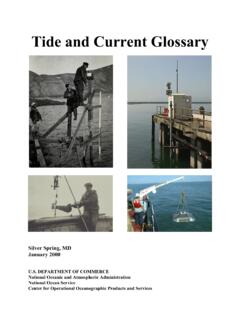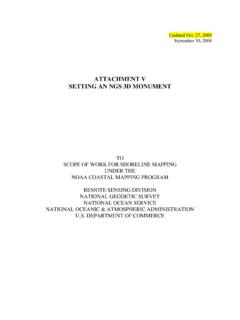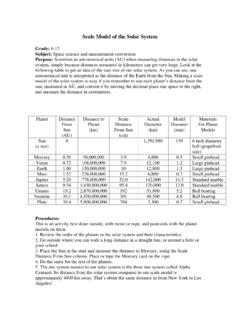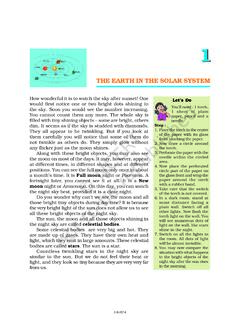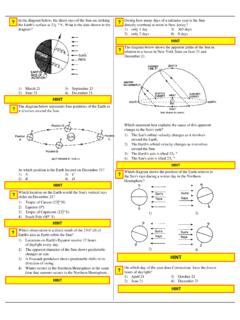Transcription of TIDES AND TIDAL DATUMS
1 UNDERSTANDING TIDESUNDERSTANDING TIDES bySteacy Dopp HicksPhysical OceanographerCenter for Operational Oceanographic Products and ServicesMichael Szabados, DirectorDecember DEPARTMENT OF COMMERCE National Oceanic and Atmospheric AdministrationNational Ocean ServiceiiThe author, Steacy D. Hicks viewing the William Ferrel tide-predictingmachine, the first tide predicting machine used in the United States(1885-1914). Photograph taken in early THE AUTHORS teacy Dopp HicksMr. Hicks retired in December 1990 after 30 years of distinguishedFederal Service, 28 years of which was providing the Nation withexpertise in TIDES and currents. A graduate of UCLA in 1950 with a majorin meteorology, Mr. Hicks received his Masters Degree in physicaloceanography from the Scripps Institution of Oceanography of theUniversity of California in 1952.
2 From 1952 to 1962, Mr. Hicks was anInstructor and Assistant Professor of Physical Oceanography at theUniversity of Rhode Island. Since entering the Federal Government (oldCoast and Geodetic Survey) in 1962, he has served in research positions;as Chief, Physical Oceanography Division; and Chief, PhysicalOceanographic Research Group; until assuming duties as Senior PhysicalOceanographer, all in the National Oceanic and AtmosphericAdministration (NOAA) and its predecessor organizations. He also hasbeen an Associate Professorial Lecturer in Physical Oceanography at TheGeorge Washington University. Mr. Hicks was selected a Fellow in thefirst class (1964-65) of the Department of Commerce Science andTechnology Fellowship Program. In the Program, he studied at theGeophysical Fluid Dynamics Laboratory of NOAA.
3 Mr. Hicks is a 1970graduate of the senior resident course (College of Naval Warfare) of Naval War College in Newport, RI. He received the Silver Medal ofthe Department of Commerce for his research on TIDES , long-periodsea-level variations, and TIDAL DATUMS ; and has authored numerous papersin refereed scientific journals on these subjects. His nine military awardsfrom WWII, while serving in the Destroyer USS Conway (DD507),include the Combat-Action Ribbon and the Asiatic-Pacific CampaignMedal with six major engagement SzabadosDirector, Center for Operational Oceanographic Products and ServicesivAcknowledgmentsI am very grateful to Michael Szabados, Director, Center for OperationalOceanographic Products and Services, for inviting me to have mymanuscript published by his organization.
4 Brenda Via was in charge ofthe entire publishing process. Leonard Hickman, my point of contact atthe beginning, was particularly helpful in coordinating the variouselements involved. My sincere thanks to both of them for theirthoroughness on my behalf. Stephen Gill revised and expanded severalimportant sections. His expertise in the harmonic analysis and predictionof TIDES was invaluable. Critical reviews by Chris Zervas on long periodsea level changes and Bruce Parker on TIDAL theory were very muchappreciated. vTABLE OF ivList of Figures .. vii1. Introduction ..12. Gravitational Attraction ..53. the sun - earth and moon - earth Systems ..7 the sun - earth System ..7 Primary development ..7 Alternative development ..9 The moon - earth System ..9 Primary development.
5 9 Alternative development .. 104. Spring and Neap, Distance and Declination .. 11 Spring and Neap TIDES .. 11 Distance .. 14 Declination .. 155. Tide-Generating Forces .. 216. Wave Motion .. 257. TIDAL Waves in Gulfs and 29 TIDES in Estuaries and Bays .. 31 TIDAL Bores .. 368. TIDAL Harmonic Constituents .. 399. Harmonic Analysis and the Prediction of TIDES .. 45 Historical Organization .. 45 Harmonic Analysis .. 45 Prediction of TIDES .. 47 Types of TIDES .. 4910. TIDAL DATUMS .. 51 TIDAL DATUMS .. 51 Hydrographic Surveying .. 53 Coastal and Marine Boundaries .. 54 Early Development of TIDAL DATUMS and Marine Boundaries in the United States .. 57viSea Level Variations .. 58 Chronology of Significant TIDAL Events in the United States .. 61 Bibliography .. 65viiLIST OF FIGURES1.
6 Envelope of tide generating forces ..82. Spring TIDES .. 123. Neap TIDES .. 124. Priming .. 135. Lagging .. 146. the sun - earth system .. 157. The moon - earth system .. 168. Diurnal inequality .. 179. Lunar node positions for diurnal inequality .. 1810. Particle trajectories of progressive wave in deep water .. 2611. Progressive wave transformation into shallow water .. 2612. Characteristics of a TIDAL wave .. 3013. TIDAL height and current relationships in a progressive TIDAL wave 3014. Formation of standing TIDAL wave from reflection .. 3115. TIDAL height and current relationships in a standing TIDAL wave .. 3216. Damping of a TIDAL wave in an estuary .. 3417. Relationship of TIDAL waves to size of estuaries .. 3518. Propagation of a TIDAL bore in a river estuary .. 3619. Constituent tide curve 3920.
7 Phase relationships for spring and neap TIDES .. 4121. Phase lag and amplitude for a harmonic constituent .. 4722. Coastal and marine boundaries from TIDAL DATUMS .. 561 CHAPTER 1 INTRODUCTIONThis book presents an elementary explanation of TIDES and tidaldatums. It is written to explain the natural phenomenon of TIDES in termsand concepts readily understandable by students as well as those in allwalks of life merely wishing to be enriched by additional knowledge oftheir environment. Also, scientists in fields other than physicaloceanography and astronomy may wish to use the book as a primer to thefundamentals of TIDAL theory. Although not at all essential to a completeunderstanding of TIDES , a mathematical development of the tide-generatingforces is 10 TIDAL DATUMS should be of particular interest to coastalzone managers, coastal engineers, geologists specializing in beachprocesses, attorneys concerned with boundary litigation, and legislators (atall government levels) representing marine activities and jurisdictionsadjacent to the sea.
8 Finally, it is hoped that new employees in the TIDES andtidal datum areas of the National Oceanic and AtmosphericAdministration will find this book a very helpful introduction to term tide is often restricted to the vertical rise and fall of the waterusually occurring twice in a little more than a day. This rise and fall arebest observed on a breakwater or on the piles of a pier. When the water isviewed near the time of its lowest point, called low tide or low water, theextent of marine growth and discoloration indicates the general range ofthe vertical excursion. The TIDAL range varies, from place to place overtime, from almost nothing to many TIDES on a sloping beach, the water moves up the beach landwardand down the beach seaward. Similarly, but on a grander scale, it movesinland and then seaward across the sloping mud flats and marshes ofestuaries as the tide alternately rises and horizontal component of this phenomenon is called the tidalcurrent.
9 It is best seen at an inlet connecting the ocean with a barriersound. The TIDAL current floods and then ebbs with slack waters inbetween. At any particular location, the high and low TIDES ; together withthe floods, ebbs, and slacks of the TIDAL current; have a particular sequenceof occurrence with near constant time intervals between each tide (in its restricted sense) and TIDAL current are both integral partsof one major phenomenon that will be called hereafter, the tide. Tides2should be thought of as being in the form of waves. These waves arethousands of miles in length. Their crests are the high TIDES , their troughs,the low TIDES , and the horizontal component of the water particles thatmake up the wave, the TIDAL currents. To complicate the matter, thesewaves combine to reinforce or interfere with each other in varyingamounts, partially contributing to the wide differences in tidalcharacteristics as actually tide is fundamentally caused by gravitational interactions betweenthe sun, moon , and earth .
10 These interactions of the gravitational forces arethe same as those causing the moon and earth to remain in their is often said of science that the ability to predict a natural event isindicative of understanding. Since TIDES are one of the most accuratelypredictable natural phenomena, it follows from the axiom that the tide istruly understood. Nothing could be further from the truth. The sciences ofastronomy and geophysics provide very accurate quantitativedeterminations of the tide-generating forces on the earth . The science ofphysical oceanography provides a detailed understanding of wavedynamics and the response of the ocean to the tide-generating Center for Operational Oceanographic Products and Services(CO-OPS) of the National Ocean Service (NOS), National Oceanic andAtmospheric Administration (NOAA) provides very accuratemeasurements of the tide over time at numerous locations throughout theUnited States and its territories.
